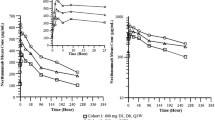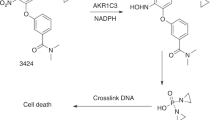Abstract
Purpose
Eftozanermin alfa is a second-generation tumor necrosis factor-related apoptosis-inducing ligand (TRAIL) receptor agonist that enhances death receptor 4/5 clustering on tumor cells to induce apoptosis. We report the pharmacokinetics and immunogenicity of eftozanermin alfa administered intravenously to 153 adults with previously-treated solid tumors or hematologic malignancies from the first-in-human, open-label, dose-escalation and dose-optimization study.
Methods
Dose escalation evaluated eftozanermin alfa monotherapy 2.5–15 mg/kg on Day 1 or Days 1/8 of a 21-day cycle. Dose optimization evaluated eftozanermin alfa monotherapy or combination therapy with either oral venetoclax 400–800 mg daily (eftozanermin alfa 1.25–7.5 mg/kg Days 1/8/15 of a 21-day cycle) or chemotherapy (eftozanermin alfa 3.75 or 7.5 mg/kg Days 1/8/15/22 of a 28-day cycle and FOLFIRI regimen [leucovorin, 5-fluorouracil, and irinotecan] with/without bevacizumab on Days 1/15 of a 28-day cycle).
Results
Systemic exposures (maximum observed concentration [Cmax] and area under the concentration–time curve [AUC]) of eftozanermin alfa were approximately dose-proportional across the entire dose escalation range with minimal to no accumulation in Cycle 3 versus Cycle 1 exposures. Comparable exposures and harmonic mean half-lives (35.1 h [solid tumors], 31.3 h [hematologic malignancies]) were observed between malignancy types. Exposures (dose-normalized Cmax and AUC) in Japanese subjects were similar to non-Japanese subjects. Furthermore, eftozanermin alfa/venetoclax combination therapy did not have an impact on the exposures of either agent. Treatment-emergent anti-drug antibodies were observed in 9.4% (13/138) of subjects.
Conclusions
The study results, including a pharmacokinetic profile consistent with weekly dosing and low incidence of immunogenicity, support further investigation of eftozanermin alfa.
Trial registration ID: NCT03082209.




Similar content being viewed by others
Data availability
AbbVie is committed to responsible data sharing regarding the clinical trials we sponsor. This includes access to anonymized, individual, and trial-level data (analysis data sets), as well as other information (eg, protocols, clinical study reports, and analysis plans), as long as the trials are not part of an ongoing or planned regulatory submission. This includes requests for clinical trial data for unlicensed products and indications. These clinical trial data can be requested by any qualified researchers who engage in rigorous, independent scientific research, and will be provided following review and approval of a research proposal, Statistical Analysis Plan (SAP), and execution of a Data Sharing Agreement (DSA). Data requests can be submitted at any time after approval in the US and Europe and after acceptance of this manuscript for publication. The data will be accessible for 12 months, with possible extensions considered. For more information on the process or to submit a request, visit the following link: https://vivli.org/ourmember/abbvie/ then select “Home”.
References
Johnstone RW, Frew AJ, Smyth MJ (2008) The TRAIL apoptotic pathway in cancer onset, progression and therapy. Nat Rev Cancer 8:782–798. https://doi.org/10.1038/nrc2465
Ashkenazi A (2002) Targeting death and decoy receptors of the tumour-necrosis factor superfamily. Nat Rev Cancer 2:420–430. https://doi.org/10.1038/nrc821
Lemke J, von Karstedt S, Zinngrebe J, Walczak H (2014) Getting TRAIL back on track for cancer therapy. Cell Death Differ 21:1350–1364. https://doi.org/10.1038/cdd.2014.81
Holland PM (2014) Death receptor agonist therapies for cancer, which is the right TRAIL? Cytokine Growth Factor Rev 25:185–193. https://doi.org/10.1016/j.cytogfr.2013.12.009
Kelley SK, Harris LA, Xie D, Deforge L, Totpal K, Bussiere J, Fox JA (2001) Preclinical studies to predict the disposition of Apo2L/tumor necrosis factor-related apoptosis-inducing ligand in humans: characterization of in vivo efficacy, pharmacokinetics, and safety. J Pharmacol Exp Ther 299:31–38
Xiang H, Nguyen CB, Kelley SK, Dybdal N, Escandón E (2004) Tissue distribution, stability, and pharmacokinetics of Apo2 ligand/tumor necrosis factor-related apoptosis-inducing ligand in human colon carcinoma COLO205 tumor-bearing nude mice. Drug Metab Dispos 32:1230–1238. https://doi.org/10.1124/dmd.104.000323
Graves JD, Kordich JJ, Huang TH, Piasecki J, Bush TL, Sullivan T, Foltz IN, Chang W, Douangpanya H, Dang T, O’Neill JW, Mallari R, Zhao X, Branstetter DG, Rossi JM, Long AM, Huang X, Holland PM (2014) Apo2L/TRAIL and the death receptor 5 agonist antibody AMG 655 cooperate to promote receptor clustering and antitumor activity. Cancer Cell 26:177–189. https://doi.org/10.1016/j.ccr.2014.04.028
Tuthill MH, Montinaro A, Zinngrebe J, Prieske K, Draber P, Prieske S, Newsom-Davis T, von Karstedt S, Graves J, Walczak H (2015) TRAIL-R2-specific antibodies and recombinant TRAIL can synergise to kill cancer cells. Oncogene 34:2138–2144. https://doi.org/10.1038/onc.2014.156
Phillips DC, Buchanan FG, Cheng D, Solomon LR, Xiao Y, Xue J, Tahir SK, Smith ML, Zhang H, Widomski D, Abraham VC, Xu N, Liu Z, Zhou L, DiGiammarino E, Lu X, Rudra-Ganguly N, Trela B, Morgan-Lappe SE (2021) Hexavalent TRAIL fusion protein eftozanermin alfa optimally clusters apoptosis-Inducing TRAIL receptors to induce on-target antitumor activity in solid tumors. Cancer Res 81:3402–3414. https://doi.org/10.1158/0008-5472.can-20-2178
Carneiro BA, El-Deiry WS (2020) Targeting apoptosis in cancer therapy. Nat Rev Clin Oncol 17:395–417. https://doi.org/10.1038/s41571-020-0341-y
Danish L, Imig D, Allgöwer F, Scheurich P, Pollak N (2018) Bcl-2-mediated control of TRAIL-induced apoptotic response in the non-small lung cancer cell line NCI-H460 is effective at late caspase processing steps. PLoS ONE 13:e0198203. https://doi.org/10.1371/journal.pone.0198203
Zhang L, Fang B (2005) Mechanisms of resistance to TRAIL-induced apoptosis in cancer. Cancer Gene Ther 12:228–237. https://doi.org/10.1038/sj.cgt.7700792
Souers AJ, Leverson JD, Boghaert ER, Ackler SL, Catron ND, Chen J, Dayton BD, Ding H, Enschede SH, Fairbrother WJ, Huang DC, Hymowitz SG, Jin S, Khaw SL, Kovar PJ, Lam LT, Lee J, Maecker HL, Marsh KC, Mason KD, Mitten MJ, Nimmer PM, Oleksijew A, Park CH, Park CM, Phillips DC, Roberts AW, Sampath D, Seymour JF, Smith ML, Sullivan GM, Tahir SK, Tse C, Wendt MD, Xiao Y, Xue JC, Zhang H, Humerickhouse RA, Rosenberg SH, Elmore SW (2013) ABT-199, a potent and selective BCL-2 inhibitor, achieves antitumor activity while sparing platelets. Nat Med 19:202–208. https://doi.org/10.1038/nm.3048
Tahir SK, Smith ML, Solomon LR, Zhang H, Xue JC, Xiao Y, Cheng D, Buchanan G, Morgan-Lappe S, Phillips DC (2017) ABBV-621 is a novel and potent TRAIL receptor agonist fusion protein that induces apoptosis alone and in combination with navitoclax and venetoclax in hematological tumors. Blood 130:2812–2812. https://doi.org/10.1182/blood.V130.Suppl_1.2812.2812
LoRusso P, Ratain MJ, Doi T, Rasco DW, de Jonge MJA, Moreno V, Carneiro BA, Devriese LA, Petrich A, Modi D, Morgan-Lappe S, Nuthalapati S, Motwani M, Dunbar M, Glasgow J, Medeiros BC, Calvo E (2022) Eftozanermin alfa (ABBV-621) monotherapy in patients with previously treated solid tumors: findings of a phase 1, first-in-human study. Invest New Drugs 40:762–772. https://doi.org/10.1007/s10637-022-01247-1
Tahir SK, Calvo E, Carnero BA, Yuda J, Shreenivas A, Jongen-Lavrencic M, Gort E, Ishizawa K, Morillo D, Biesdorf C, Smith M, Cheng D, Motwani M, Sharon D, Uziel T, Modi DA, Buchanan FG, Morgan-Lappe S, Medeiros BC, Phillips DC (2023) Activity of eftozanermin alfa plus venetoclax in preclinical models and patients with acute myeloid leukemia. Blood 141:2114–2126. https://doi.org/10.1182/blood.2022017333
Douillard JY, Cunningham D, Roth AD, Navarro M, James RD, Karasek P, Jandik P, Iveson T, Carmichael J, Alakl M, Gruia G, Awad L, Rougier P (2000) Irinotecan combined with fluorouracil compared with fluorouracil alone as first-line treatment for metastatic colorectal cancer: a multicentre randomised trial. Lancet 355:1041–1047. https://doi.org/10.1016/s0140-6736(00)02034-1
Liu H, Michmerhuizen MJ, Lao Y, Wan K, Salem AH, Sawicki J, Serby M, Vaidyanathan S, Wong SL, Agarwal S, Dunbar M, Sydor J, de Morais SM, Lee AJ (2017) Metabolism and disposition of a novel B-cell lymphoma-2 inhibitor venetoclax in humans and characterization of Its unusual metabolites. Drug Metab Dispos 45:294–305. https://doi.org/10.1124/dmd.116.071613
Liu L (2015) Antibody glycosylation and its impact on the pharmacokinetics and pharmacodynamics of monoclonal antibodies and Fc-fusion proteins. J Pharm Sci 104:1866–1884. https://doi.org/10.1002/jps.24444
Chen X, Zaro JL, Shen WC (2012) Pharmacokinetics of recombinant bifunctional fusion proteins. Expert Opin Drug Metab Toxicol 8:581–595. https://doi.org/10.1517/17425255.2012.673585
Vugmeyster Y, Xu X, Theil FP, Khawli LA, Leach MW (2012) Pharmacokinetics and toxicology of therapeutic proteins: advances and challenges. World J Biol Chem 3:73–92. https://doi.org/10.4331/wjbc.v3.i4.73
Zhao L, Ren TH, Wang DD (2012) Clinical pharmacology considerations in biologics development. Acta Pharmacol Sin 33:1339–1347. https://doi.org/10.1038/aps.2012.51
Keizer RJ, Huitema AD, Schellens JH, Beijnen JH (2010) Clinical pharmacokinetics of therapeutic monoclonal antibodies. Clin Pharmacokinet 49:493–507. https://doi.org/10.2165/11531280-000000000-00000
Liu L (2018) Pharmacokinetics of monoclonal antibodies and Fc-fusion proteins. Protein Cell 9:15–32. https://doi.org/10.1007/s13238-017-0408-4
Konopleva M, Pollyea DA, Potluri J, Chyla B, Hogdal L, Busman T, McKeegan E, Salem AH, Zhu M, Ricker JL, Blum W, DiNardo CD, Kadia T, Dunbar M, Kirby R, Falotico N, Leverson J, Humerickhouse R, Mabry M, Stone R, Kantarjian H, Letai A (2016) Efficacy and biological correlates of response in a phase II study of venetoclax monotherapy in patients with acute myelogenous leukemia. Cancer Discov 6:1106–1117. https://doi.org/10.1158/2159-8290.CD-16-0313
Salem AH, Agarwal SK, Dunbar M, Enschede SL, Humerickhouse RA, Wong SL (2017) Pharmacokinetics of venetoclax, a novel BCL-2 inhibitor, in patients with relapsed or refractory chronic lymphocytic leukemia or non-hodgkin lymphoma. J Clin Pharmacol 57:484–492. https://doi.org/10.1002/jcph.821
Roberts AW, Davids MS, Pagel JM, Kahl BS, Puvvada SD, Gerecitano JF, Kipps TJ, Anderson MA, Brown JR, Gressick L, Wong S, Dunbar M, Zhu M, Desai MB, Cerri E, Heitner Enschede S, Humerickhouse RA, Wierda WG, Seymour JF (2016) Targeting BCL2 with venetoclax in relapsed chronic lymphocytic leukemia. N Engl J Med 374:311–322. https://doi.org/10.1056/NEJMoa1513257
Chirmule N, Jawa V, Meibohm B (2012) Immunogenicity to therapeutic proteins: impact on PK/PD and efficacy. AAPS J 14:296–302. https://doi.org/10.1208/s12248-012-9340-y
Acknowledgements
AbbVie and authors thank all the study investigators and patients who participated in this clinical trial. Writing and editorial assistance was provided by AbbVie employee Wesley Wayman, PhD and Lorraine R. Baer, PharmD (Baer PharMed Consulting, Ltd.), with funding provided by AbbVie.
Disclosures
All authors had access to relevant data and participated in the drafting, review, and approval of this manuscript. No honoraria or payments were made for authorship.
Funding
AbbVie funded and participated in the study design, research, analysis, data collection, interpretation of data, reviewing, and approval of the manuscript.
Author information
Authors and Affiliations
Corresponding author
Ethics declarations
Conflict of interest
Carla Biesdorf, Satya R. Siddani, David Hoffman, Nils Boehm, Bruno C. Medeiros, Rajeev M. Menon, and Akshanth R. Polepally are current employees of AbbVie Inc. and may own stock. Xiaowen Guan was an employee of AbbVie Inc. at the time of study conduct and may own stock. Toshihiko Doi is an employee of National Cancer Center Hospital East and has received research funding from Abbvie, Inc., Maja de Jonge is an employee of Erasmus Medisch Centrum and has received research funding from Abbvie, Inc., Drew Rasco is an employee of South Texas Accelerated Research Therapeutics (START) and has received research funding from Abbvie, Inc.
Ethics approval
The study protocol and all other study-related documents were reviewed and approved by an ethics committee/independent institutional review board (IRB) at each participating site. All subjects provided written, informed consent prior to the start of any screening or study-specific procedures. The study was conducted in accordance with the protocol, International Council for Harmonisation of Technical Requirements for Pharmaceuticals for Human Use (ICH) guidelines, applicable regulations, and guidelines governing clinical study conduct and ethical principles that have their origin in the Declaration of Helsinki.
Additional information
Publisher's Note
Springer Nature remains neutral with regard to jurisdictional claims in published maps and institutional affiliations.
AbbVie was the affiliation for Xiaowen Guan, PhD, at the time of study conduct.
Supplementary Information
Below is the link to the electronic supplementary material.
Rights and permissions
Springer Nature or its licensor (e.g. a society or other partner) holds exclusive rights to this article under a publishing agreement with the author(s) or other rightsholder(s); author self-archiving of the accepted manuscript version of this article is solely governed by the terms of such publishing agreement and applicable law.
About this article
Cite this article
Biesdorf, C., Guan, X., Siddani, S.R. et al. Pharmacokinetics and immunogenicity of eftozanermin alfa in subjects with previously-treated solid tumors or hematologic malignancies: results from a phase 1 first-in-human study. Cancer Chemother Pharmacol 93, 329–339 (2024). https://doi.org/10.1007/s00280-023-04613-9
Received:
Accepted:
Published:
Issue Date:
DOI: https://doi.org/10.1007/s00280-023-04613-9




